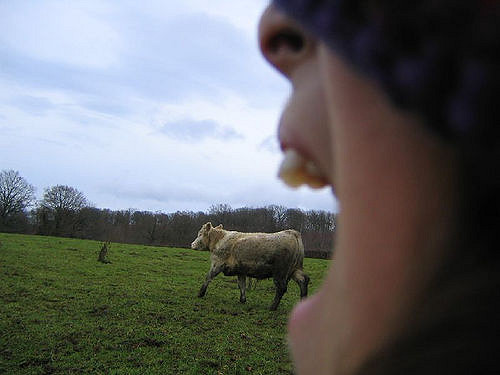
“Sometimes people hold a core belief that is very strong. When they are presented with evidence that works against that belief, the new evidence cannot be accepted. It would create a feeling that is extremely uncomfortable, called cognitive dissonance. And because it is so important to protect the core belief, they will rationalize, ignore and even deny anything that doesn’t fit in with the core belief.” ~ Frantz Fanon, Black Skin, White Masks
~
According to The United Nations Food and Agriculture Organization, in 2016, approximately 795 million people out of 7.3 billion people in the world were suffering from chronic undernourishment, and almost all of them live in developing countries—with children being the most visible victims of undernutrition.
However, the world produces enough food to feed everyone, therefore, no person living on this planet should ever go hungry.
According to a United Nations report, the current world population is projected to increase by one billion over the next 12 years and calculated to reach 9.6 billion by 2050. The majority of growth will be in developing countries, with more than half in Africa.
Poverty is one of the main reasons given to explain why so many people are hungry, but many people are poor because they are hungry, as hunger causes poor health, smaller body size, low-energy levels, and it reduces mental functioning, which then reduces their ability to work or to learn.
According to a report by former UN Secretary General and President of the Global Humanitarian Forum, Kofi Annan, climate change is responsible for 300,000 deaths every year and greatly impacts approximately 325 million people. Annan states that, due to climate change, currently four billion people are vulnerable, and 500 million people are at extreme risk.
Annan’s report stated that if emissions are not brought under control within 25 years, increases in temperature will cause a further 310 million people to suffer adverse health consequences, 20 million more people to fall into poverty, and 75 million more people to be displaced.
Annan explained, “Global warming is expected to increasingly impact food security, water availability and quality, and exact a toll on public health, spurring chronic disease, malaria prevalence, and cardiovascular and respiratory diseases.”
The study also found that the most severely affected places are Africa, Bangladesh, Egypt, coastal zones, and forest areas.
Nobel Peace Prize winner Wangari Maathai, explains, “Climate change is life or death. It is the new global battlefield. It is being presented as if it is the problem of the developed world. But it’s the developed world that has precipitated global warming.”
Research has found that the main thing that is harming both the health of people and the planet is climate change, and the main reason for climate change is believed to directly relate to our food choices.
University of Minnesota Professor of Ecology G. David Tilman and graduate student Michael Clark examined almost 50 years worth of data from the world’s most populated countries and found that diet trends are contributing to ever-rising agricultural greenhouse gas emissions and habitat degradation. In their report, Tilman and Clark explained, “These dietary shifts are greatly increasing the incidence of Type 2 diabetes, coronary heart disease, and other chronic non-communicable diseases that lower global life expectancies.”
Tilman and Clark also found that when personal incomes increased between 1961 and 2009, people started to consume more meat protein, also known as “empty calories” and the total calories per person skyrocketed. “Empty calories” are classed as sugar, fat, oils, and alcohol, and the research showed that they account for almost 40 percent of food consumed in 15 of the world’s wealthiest countries.
When the researchers combined the trends with forecasts of population and income growth for the coming decades, they were able to project that if current diet shifts continue, by 2050 diets will contain fewer servings of fruits and vegetables, approximately 60 percent more empty calories, and 25-50 percent more pork, poultry, beef, dairy, and eggs.
Therefore, as millions of consumers in the first world are suffering or dying from illness brought on by eating animal products, the world’s poorest people are dying from poverty and illnesses related to those same food choices.
The food we are eating is not only making us sick, it is also wreaking ecosystem-level havoc, and forcing global climate change.
To see the list of health issues that can be caused by animal feeding operations, please click here.
The livestock industry is linked to a wide variety of health related concerns. These include air quality problems caused by gases emitted from the decomposition of animal wastes, as well as the dust generated by animal activity and farming practices. These air pollutants are connected with respiratory illness, lung inflammation, and can increase vulnerability to respiratory diseases, such as asthma.
Tilman also explained, “The same dietary changes that can add about a decade to our lives can also prevent massive environmental damage. In particular, if the world were to adopt variations on three common diets, health would be greatly increased at the same time global greenhouse gas emissions would be reduced by an amount equal to the current greenhouse gas emissions of all cars, trucks, planes, trains, and ships. In addition, this dietary shift would prevent the destruction of an area of tropical forests and savannas as large as half of the United States.”
Comparing health impacts of global diets, the study found that eliminating an omnivorous diet and opting for a traditional Mediterranean, pescatarian, or vegetarian diet could reduce Type 2 diabetes by around 24 percent, cancer by around 10 percent, and heart disease deaths by around 20 percent.
“Some of what we found is not surprising, but the global implications are frightening,” Tilman says. “Most of us have heard that some diets are healthier, that eating too many calories is bad for you, and that red meat harms the environment. We were surprised at how rapidly and consistently diets were changing around the world, how massively this would impact global health, and how much it would increase global greenhouse gas emissions and the destruction of tropical forests and other ecosystems.”
A study carried out by the Netherlands Environmental Assessment Agency’s Climate Benefits of Changing Diet (2009) evaluated how dietary changes could reduce the costs of climate change. It found that a diet without ruminant animals (cattle, sheep, and goats)—which produce the most methane—could reduce climate change by 50 percent. However, switching to a diet that included no animal products, i.e., not even eggs or milk, could reduce climate change by more than 80 percent.
Then, there’s water. Worldwatch Institute chairman Lester Brown states, “In consumption terms, 480 million of the world’s six billion people are being fed with food produced with the unsustainable use of water. We are already using up the water which belongs to our children.”
Facts supporting the above, taken from Cowspiracy:
Animal agriculture is responsible for 18 percent of greenhouse gas emissions. This is more than the combined exhaust from all transportation across the world. 13 percent of all greenhouse gas emissions comes from transportation exhaust.
Fifty-one percent of all worldwide greenhouse gas emissions are from livestock and their byproducts, which produce 32,000 million tons of carbon dioxide (CO2) every year.
Livestock is responsible for 65 percent of all human-related emissions of nitrous oxide, which is a greenhouse gas that has 296 times the global warming potential of CO2. It stays in the atmosphere for 150 years.
Agriculture emissions are expected to increase 80 percent by 2050.
Every day cows produce 150 billion gallons of methane.
Benefits would be seen immediately by reducing methane emissions (as opposed to measures taken to reduce fossil fuel usage, which take decades).
Water consumption from animal agriculture ranges from 34-76 trillion gallons per year.
80-90 percent of U.S. water consumption is used by agriculture.
56 percent of water in the U.S. is used to grow feed crops for livestock.
It would take over 20 years and approximately 43 trillion dollars to convert to wind and solar power.
Californians use 1,500 gallons of water every day per person. Half of that number is associated to meat and dairy products.
To produce one pound of beef 2,500 gallons of water are required.
To produce one pound of cheese almost 900 gallons of water are required.
To produce one gallon of milk 1,000 gallons of water are required.
In the U.S., five percent of water consumed is by private homes and 55 percent of water is consumed for animal agriculture.
Livestock and livestock feed covers 1/3 of earth’s ice-free land and 45 percent of earth’s total land.
Erik Solheim, head of U.N. Environment, explained in a news release, “If we don’t start taking additional action now…we will grieve over the avoidable human tragedy. The growing numbers of climate refugees hit by hunger, poverty, illness, and conflict will be a constant reminder of our failure to deliver. The science shows that we need to move much faster.”
If everyone consumed a vegetarian diet, we would be able to sustain the lives of 10 billion people just through our present croplands. If Americans alone reduced their intake of meat by just 10 percent, it would result in 100,000,000 people being fed by using the land, water, and energy that would be freed up from growing livestock feed.
Although many organizations are working hard to fight climate change, to promote sustainable, alternative diets, and educate consumers about the environmental and health effects of our food choices, rather than waiting and hoping that the industries will make significant changes, we can all help immediately by altering our diets and purchasing food from local, ethical, sustainable sources which use much less water, energy, and land.
It is not the only reason, but the main reason people are going hungry is because we are using up Earth’s resources by feeding animals so that rich people can eat their meat. Therefore, it becomes a vicious cycle—the more meat we consume, the more people go hungry.
Simply by eliminating or reducing our meat consumption, making ethical, conscious decisions, and helping to raise awareness, we will collectively make a dramatic difference in our health, the environment, the treatment of animals, and global poverty and hunger.
~
~
~
Author: Alex Myles
Image: Flickr/coincoyote
Editor: Travis May







Read 4 comments and reply